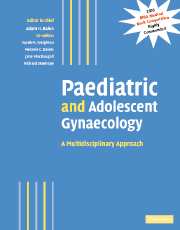Book contents
- Frontmatter
- Contents
- Contributors
- Preface
- Part I Normal development
- Part II Management of developmental abnormalities of the genital tract
- 9 Management of ambiguous genitalia at birth
- 10 Imaging of the female pelvis in the evaluation of developmental anomalies
- 11 Surgical correction of vaginal and other anomalies
- 12 Laparoscopic techniques
- 13 A nonsurgical approach to the treatment of vaginal agenesis
- 14 Psychological care in disorders of sexual differentiation and determination
- 15 The needs of the adolescent patient and her parents in the clinic
- 16 Communicating a diagnosis
- 17 Patients and parents in decision making and management
- Part III Management of specific disorders
- Index
- Plate section
- References
11 - Surgical correction of vaginal and other anomalies
from Part II - Management of developmental abnormalities of the genital tract
Published online by Cambridge University Press: 04 May 2010
- Frontmatter
- Contents
- Contributors
- Preface
- Part I Normal development
- Part II Management of developmental abnormalities of the genital tract
- 9 Management of ambiguous genitalia at birth
- 10 Imaging of the female pelvis in the evaluation of developmental anomalies
- 11 Surgical correction of vaginal and other anomalies
- 12 Laparoscopic techniques
- 13 A nonsurgical approach to the treatment of vaginal agenesis
- 14 Psychological care in disorders of sexual differentiation and determination
- 15 The needs of the adolescent patient and her parents in the clinic
- 16 Communicating a diagnosis
- 17 Patients and parents in decision making and management
- Part III Management of specific disorders
- Index
- Plate section
- References
Summary
Historical perspective
The surgical correction of vaginal anomalies dates from the early 1800s. Surgery on the clitoris is a more recent practice and has evolved over the last 50 years or so. The existence of uterine anomalies was first noted in 1681 by Dionis, who described simultaneous pregnancies in each side of a hemi-uterus (Letterie, 1998). Their impact on reproduction was recognized but the first systematic review was not until 1922 (Miller, 1992). The first metroplasty was described in 1884 by Ruge.
Correction of vaginal anomalies
Many different techniques to create or reconstruct a vagina have been described by a variety of different authors, which suggests that there continues to be controversy over the optimal form of surgery. The evidence base on which to select a particular technique is limited to, at best, a series of case reports with short-term follow-up. This is, in part, inevitable because of the rarity of these conditions, but it does not help decision making. It is useful to look at how and what prompted the development of these various techniques (Schober et al., 1998).
Dupuytren described the first vaginoplasty in 1817 (Judin, 1927). This involved creating a perineal pouch between bladder and rectum. Wharton (1938) and Counsellor (1948) subsequently refined this technique by using a mould to hold the pouch open, which allowed spontaneous epithelialization to take place.
- Type
- Chapter
- Information
- Paediatric and Adolescent GynaecologyA Multidisciplinary Approach, pp. 120 - 130Publisher: Cambridge University PressPrint publication year: 2004
References
- 3
- Cited by

